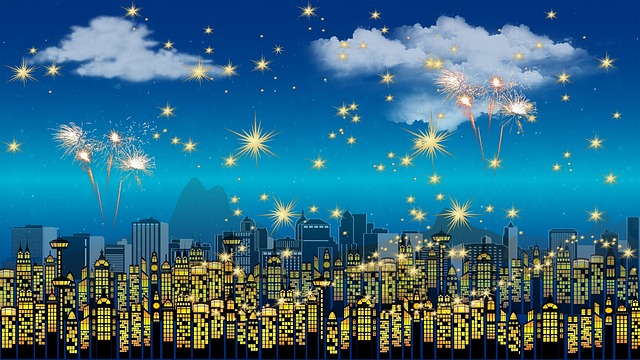 Submitted by Julia on
Submitted by Julia on

pixabay.com
New Year’s is one of the oldest holidays still celebrated, but the exact date and nature of the festivities have changed over time. It originated thousands of years ago in ancient Babylon, celebrated as an eleven day festival on the first day of spring. During this time, many cultures used the sun and moon cycle to decide the “first” day of the year. It wasn’t until Julius Caesar implemented the Julian calendar that January 1st became the common day for the celebration. The content of the festivities has varied as well. While early celebrations were more paganistic in nature, celebrating Earth’s cycles, Christian tradition celebrates the Feast of the Circumcision of Christ on New Year’s Day. Roman Catholics also often celebrate Solemnity of Mary, Mother of God, a feast honoring Mary. However, in the twentieth century, the holiday grew into its own celebration and mostly separated from the common association with religion. It has become a holiday associated with nationality, relationships, and introspection rather than a religious celebration, although many people do still follow older traditions.
While celebration varies all over the world, common traditions include:
This especially includes circle-shaped foods, which symbolize cycles. The reasoning behind superstitions is that the first day of the year sets precedent for the following days. A common superstition specific to New Year’s Day concerns a household’s first visitor of the year—tradition states that if a tall, dark-haired stranger is the first to walk through your door, called the First Footer or Lucky Bird, you’ll have good luck all year. Also, if you want to subscribe to superstition, don’t let anything leave the house on New Year’s, except for people. Tradition say’s: don’t take out the trash and leave anything you want to take out of the house on New Year’s outside the night before. If you must remove something, make sure to replace it by bringing an item into the house. These policies of balance apply in other areas as well—avoiding paying bills, breaking anything, or shedding tears.
Toasts typically concern gratefulness for the past year’s blessings, hope and luck or the future, and thanking guests for their New Year’s company. In coastal regions, running into a body of water or splashing water on one another, symbolizing the cleansing, “rebirth” theme associated with the holiday.
However, many nations and cultures within them have their own characteristic way of celebrating:
- Making resolutions or goals to improve one’s life.
- Common resolutions concern diet, exercise, bad habits, and other issues concerning personal wellness. A common view is to use the first day of the year as a clean slate to improve one’s life.
- A gathering of loved ones: Here you’ll typically find champagne, feasting, confetti, noise makers, and other methods of merriment Fireworks, parades, concerts.
- Famous parades include London’s New Year’s Day Parade and the Rose Parade in Pasadena, California. Superstitions concerning food or visitors to bring luck.
- Toasting
American Citizens often celebrate with a party featuring toasting, drinking and fireworks late into the night before the New Year, where the gathering counts down the final seconds to January 1st. Some might even get a kiss at midnight. Many English speaking countries play “Auld Lang Syne,” a song celebrating the year’s happy moments. Americans often make resolutions and watch the Time Square Ball drop in New York City. Although much of this celebration occurs the night before, the merrymaking typically continues to New Year’s Day. Football is a common fixture on New Year’s Day in America, usually the day of the Rose Bowl. Some foods considered “lucky” to eat during the festivities include:
Circular shaped foods
Black-eyed peas
Cabbage
Pork
New Years France
The French typically celebrate New Year’s with a feast and a champagne toast, marking the first moments of New Year’s Day with kisses under the mistletoe, which most other cultures associate with Christmas celebrations. The French also consider the day’s weather as a forecast for the upcoming year’s harvest, taking into account aspects like wind direction to predict the fruitfulness of crops and fishing.
New Years Phillipines
In the Philippines, celebrations are very loud, believing that the noise will scare away evil beings. There is often a midnight feast featuring twelve different round fruits to symbolize good luck for the twelve months of the year. Other traditional foods include sticky rice and noodles, but not chicken or fish because these animals are food foragers, which can be seen as bad luck for the next year’s food supply.
Greece
Greeks celebrate New Year’s Day with card games and feasting. At midnight, the lights are turned off, followed by the Basil’s Pie, which contains a coin. Whoever gets the piece of pie containing the coin wins luck for the next year.
New Years Soviet Union
The Soviet Union’s New Year’s Day celebrations have been greatly affected by the Union’s history. As religion was suppressed and Christmas celebrations were banned, New Year’s, or Novi God celebrations often include Christmas traditions such as decorated trees, which were reconsidered as New Year Fir Trees. As the suppression left, these traditions stayed part of the New Year’s Day celebration. The holiday is also celebrated with feasts, champagne, and wishes.
New Years Spain
Spaniards celebrate New Year’s Day with the custom of eating twelve grapes, each eaten at a clock-stroke at midnight.
Cold-water plunges
In colder countries close to water, such as Canada, parts of the United States, the United Kingdom, and the Netherlands, it is customary to organize cold-water plunges. These plunges and races, sometimes called a Polar Bear Plunge, often raise money for charity or awareness for a cause.
For thousands of years, New Year’s has been a festival of rebirth and reflection, allowing people all over the world to celebrate another great year.
New Year’s Song
The song, “Auld Lang Syne,” is sung at the stroke of midnight in almost every English-speaking country in the world to bring in the new year. At least partially written by Robert Burns in the 1700’s, it was first published in 1796 after Burns’ death. Early variations of the song were sung prior to 1700 and inspired Burns to produce the modern rendition. An old Scottish tune, “Auld Lang Syne” literally means “old long ago,” or simply, “the good old days.”
http://wilstar.com/holidays/newyear.htm
- 1864 reads